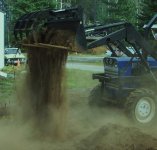I love reading these post with action pics and testimony. This site is invaluable to new guys when looking to buy. Once I found this site I could NOT go without checking it DAILY!!
FINALLY, I have some input on this topic as we pulled the trigger on a new tractor and grapple set up. Trying to decide on one with so many models, weights, clamp types, and bucket forms was tough. We went with a model the dealer had on the lot as he provided the hook ups for us on our tractor when we bought.....so the work was pretty much done for us. The model was a 6 foot model called an ETG Worksaver.
Worksaver ETG Series Sjid Steer Tine Grapple
Since we bought I have had about 20 hours of work time with it. It worked great for combing out black berry bushes and the roots from our fields. Just drop and front leading edge to the pipe cross bar and drive. The pipe gives the edge a depth gauge as to not dig too deep in the ground as it rips out the roots. At the end of the run just bump the clamp lever ( on my auxiliary remote controls) and clamp the big snarl of blackberry bushes and roots.
I also played with knocking over cedar trees with the grapple. With the clamp arm opened and the toothed edge leading, i can push about 4 feet up on a 4-7 inch cedar tree and lay it down with out snapping it. (Helps to have a good soaking rain or wet spring ground to do this) The roots just pop out when the tree lays down. Then the grapple comes in from the bottom and grips the rest of the root systems lifts the whole tree up and out. When you clamp on the root ball/tree base, you can stack the entire tree nicely for burning later. I have cleared a few acres this way already for new pasture lands. What I noticed was nice about the single over arm clamp is that you can grab heavy objects and have the load balanced straight out the front of the loader and not have offset weight on the loader frame as a dual clamp grapple may get you. The clamp edge as teeth, which helps grab root ball/tree bottoms. Other grapples have more of a fang type top clamp look to them and can not grab the tree roots/bases when you tip them over.
It was not the best for trying to uproot smaller cedars and trees. it would do more damage to the ground trying to comb out the smaller tree roots and/or snap the sapling off while trying to push it over...... but i have that problem solved already. Last night my tree puller arrived and i already have about 3-4 hrs of use on it!
Back on track now....
Another nice feature of this grapple was the ability to pick up small sticks/branches with the grapple tips. The bucket on my tractor angles down and i can clamp on one small item with precision as the grapple tips to not over lap or pass each other.... they clamp tip to tip.
Complaints that I may have are that the gaps between the bottom rails are too far apart and cannot hold smaller rocks....BUT, so far i can live with that.
I have used it with aggression with our 60 HP tractor and haven't seen any weak points at all. I felt i would break something on the tractor before the grapple!!


